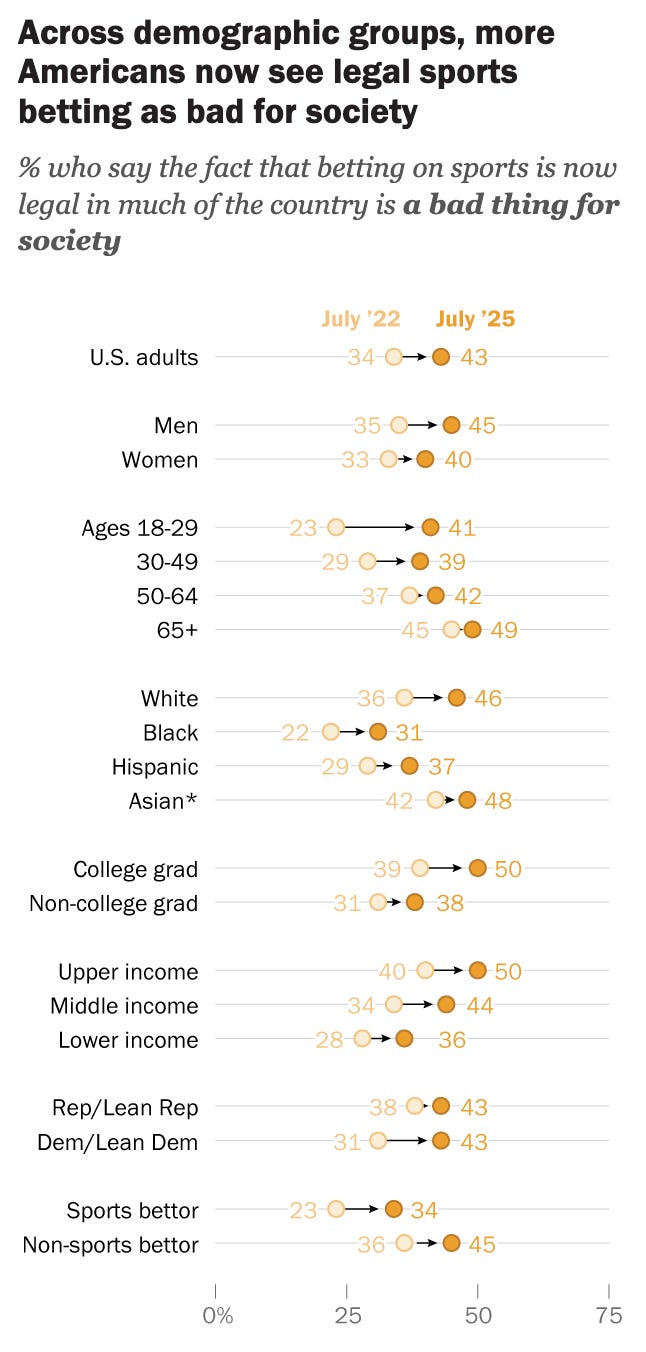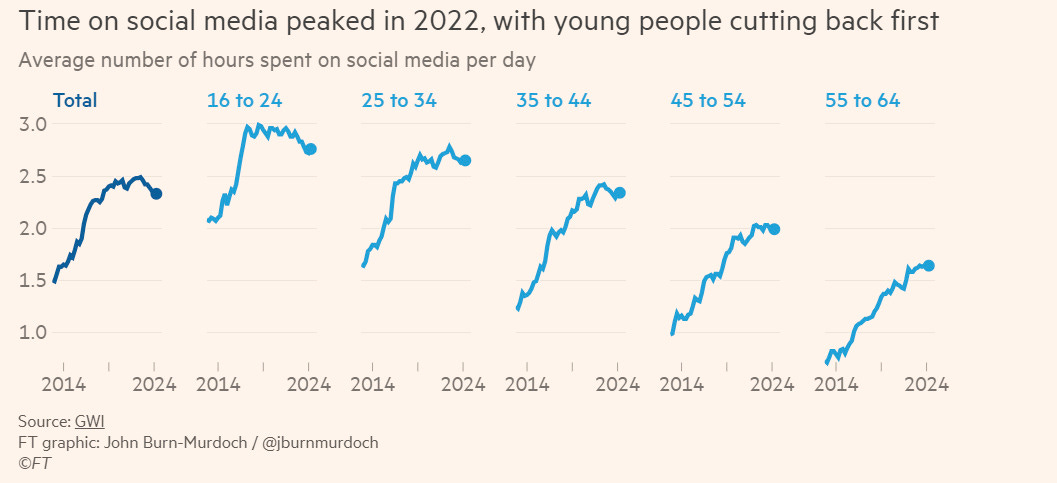🌀🗞 The FLUX Review, Ep. 210
October 9th, 2025

Episode 210 — October 9th, 2025 — Available at read.fluxcollective.org/p/210
Contributors to this issue: Neel Mehta, Boris Smus, Spencer Pitman, Erika Rice Scherpelz, Justin Quimby, MK
Additional insights from: Ade Oshineye, Anthea Roberts, Ben Mathes, Dart Lindsley, Jasen Robillard, Lisie Lillianfeld, Robinson Eaton, Stefano Mazzocchi, Wesley Beary, and the rest of the Flux Collective
We’re a ragtag band of systems thinkers who have been dedicating our early mornings to finding new lenses to help you make sense of the complex world we live in. This newsletter is a collection of patterns we’ve noticed in recent weeks.
“There are problems that are impossible if you think about them in two-years terms...but they’re easy if you think about them in fifty-years terms.”
— Danny Hills
🤝❣️ The BATNA in your heart
A startup founder sits across from a potential investor. On paper, their BATNA (best alternative to a negotiated agreement) is clear: if they don’t close this round, they’ll bootstrap for another six months and revisit fundraising later. But in their heart, the stakes feel higher. A voice whispers that if this deal falls apart, they’ll be finished, their company a failure, their career derailed. That story isn’t their actual fallback, yet it shapes how they carry themselves in the room.
Formally, a BATNA is the course of action you can fall back on if a negotiation doesn’t succeed. It’s meant to give you leverage and clarity, a rational benchmark for deciding whether to walk away or keep engaging. In theory, it’s something we think through calmly. In practice, they can have an emotional element: the BATNA in your heart is the story you tell yourself about the negotiation. Sometimes the two align. Often they don’t.
The BATNA in your heart is powerful because it shapes your stance. Whatever you rationally believe, what you feel impacts how you show up. If you believe that failure means catastrophe, you’ll cling too tightly and concede too quickly. If you believe that something better awaits, you risk overplaying your hand. The rational BATNA keeps you grounded. The heart BATNA animates your presence.
Negotiations are rarely just about the deal on the table. They’re also about managing the stories you’re telling yourself. The “emotional markup” on your BATNA can be positive, fueling resilience, or negative, fueling panic… but it’s rarely neutral. In group settings, the challenge multiplies: teams often have multiple heart BATNAs swirling around the table, unspoken misalignments that can quietly sabotage their strategy.
It isn’t enough to map the rational BATNA. You also need to surface the heart BATNA. Ask: What do I fear will happen if this fails? What do I hope will happen? Lay these out side by side with the rational fallback.
The simple act of naming the heart BATNA makes it less likely to hijack behavior. And when you notice a counterpart negotiating from a place of excess hope or fear, it might be their heart BATNA showing through—something you can respond to with empathy rather than confusion or hostility.
🛣️🚩 Signposts
Clues that point to where our changing world might lead us.
🚏☀️ Renewable energy is now the world’s biggest source of electricity
Wind and solar energy combined now generate more electricity than coal for the first time in history. Even though electricity consumption is increasing, recent growth in renewables met over 100% of the world’s increased energy demand—driving a net decrease in coal and natural gas usage. Solar growth is concentrated in the developing world: 58% of solar generation now occurs in low-income countries. China added more solar and wind capacity than the rest of the world combined; India also installed enough solar and wind to reduce its fossil fuel consumption. (By contrast, the US, and the EU are increasing their usage of fossil fuels.)
🚏⚾ Sports betting is booming, but more and more Americans say it’s a bad thing
Sports betting has exploded in popularity in the US since it was made legal in 2018; the industry raked in a record $13.7 billion in 2024, breaking the previous year’s record of $11 billion. But despite sports betting’s rising popularity, an ever-increasing share of Americans think it’s a bad thing for society: 43% of adults now think it’s bad for society, up from 34% in 2022. The rise was consistent across every demographic group Pew Research Center polled. Interestingly, the increase in negative views was greatest among adults aged 18–29, the age group that bets most on sports.
🚏📽️ Sora 2 watermark removers are all over the internet
Videos made by OpenAI’s new video generation tool, Sora 2, come with a small watermark to show that they’re AI-generated. But countless Sora 2 watermark removal sites have popped up across the internet, and watermark-free Sora videos have started going viral on social media: one infamous video about a woman proposing to a stranger on the subway racked up 5 million likes on TikTok.
🚏📴 Social media usage peaked in 2022 and has declined since then
New data from the Financial Times shows that the amount of time that people spent on social media peaked in 2022 at around 2.5 hours per day, and it’s declined almost 10% since then. (North America is an exception: social media usage continues to increase there.) The remaining usage of social media isn’t very “social” anymore: the share of people who use social media to ‘stay in touch with friends’ or ‘express themselves’ has fallen by more than 25% since 2014.
📖⏳ Worth your time
Some especially insightful pieces we’ve read, watched, and listened to recently.
On Slop (John David Pressman) — Seeks to define the nebulous term “slop” (of “AI slop” fame) by comparing it to spam, cliche, and kitsch. While spam comes from supply (someone has junk to sell and wants to find buyers), slop comes from demand (people want this emotional junk food, even if it’s fake). And while kitsch is “nostalgic” and “unchallenging,” slop is purposely “bizarre,” “surreal,” and “sensationalist,” because that’s what drives engagement. Perhaps the defining feature of slop is that “you can fully infer the generator”: its outputs are low entropy and wholly determined by the prompt, making them feel “nauseating” and shallow once you’ve seen enough.
The “Traffic Light” Approach to Problem Solving (Guy Rosen) — Proposes a decision matrix that forces rigorous thinking through radical simplification. Create a table with criteria as rows and options as columns, then color each cell green (good fit), yellow (decent), or red (poor fit). For example, choosing between job offers might use criteria like “learning opportunity,” “work-life balance,” and “compensation”, thus instantly revealing which option performs consistently well versus those with fatal flaws. The visual clarity cuts through analysis paralysis and exposes hidden assumptions about what actually matters.
LLMs, Shifting Baselines, and .400 Hitters (Paul Kedrosky) — Observes that extremely high batting averages in baseball (like Ted Williams’ famous .406 season) disappeared not because players got worse, but because they got better: as pitchers and fielders improved, it became harder for hitters to excel. When overall skill increases, the floor rises faster than the ceiling, thus reducing variance and making extraordinary outcomes more rare. LLMs’ ability to give everyone some baseline level of creative ability may portend similar patterns in human creative output.
Hollow at the Base (India Dispatch) — Describes how massive tech outsourcing companies like Tata Consulting Services and Infosys have become “the very backbone” of India’s middle class, employing millions of young college grads and growing them into well-paid professionals. But in recent years, perhaps due to AI, these firms have slashed their hiring, especially of junior employees, which threatens to break down India’s miraculous middle-class building machine.
🔍📆 Lens of the week
Introducing new ways to see the world and new tools to add to your mental arsenal.
This week’s lens: the XY problem.
After a developer has spent hours debugging their code to simulate keyboard input, a teammate asks: “What are you trying to do?” “I want to trigger a search box automatically.” Turns out, there’s an API call for that with no hacks required.
The XY problem happens when people ask for help with a proposed fix (X) instead of the underlying issue (Y… “why?”). The question detaches from its context, and the energy of problem-solving flows sideways. The result is a clever answer to the wrong question.
It’s easy to see why this happens. “How do I do X?” feels efficient. It signals progress (and makes us feel smart). In a world that rewards speed and certainty, declaring the problem solved feels safer than sitting in ambiguity.
But this local optimization has a cost. When we act on surface questions, we harden our assumptions into architecture. Workarounds become the default. Soon, no one remembers why the system works the way it does, only that it does (mostly).
To break the loop, don’t answer the question. Surface the intent behind it. Ask, “What are we really trying to solve here?” Clarity upstream saves orders of magnitude downstream.
© 2025 The FLUX Collective. All rights reserved. Questions? Contact flux-collective@googlegroups.com.


